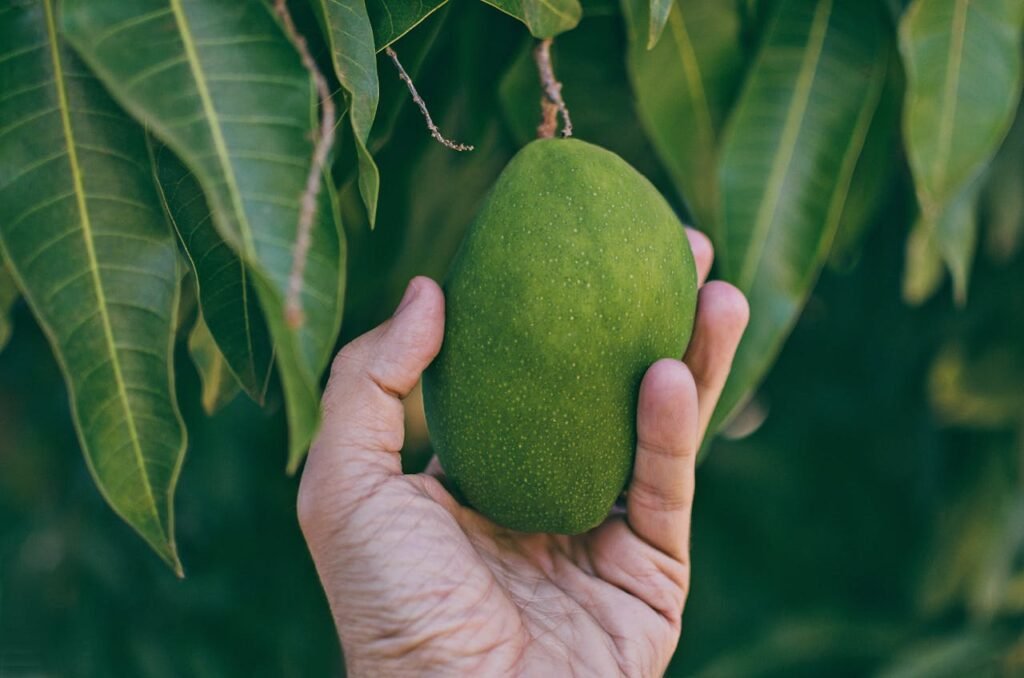
32 Mango Varieties in India to Soothe Your Summer Days
Living in India and don’t know about mango varieties in India? then here you are going to know about 32 mango varieties in India.

Mangoes, scientifically known as Mangifera indica, belong to the Anacardiaceae family. These luscious fruits are native to tropical regions and are closely related to cashews and pistachios. Let’s dive into the juicy details about mango verities in India and more:
Origin and Significance of Mangoes
National Fruit of India: Mangoes are special in Indian culture and cuisine. They are revered as the “king of fruits” and symbolize abundance, love, and celebration.

National Tree of Bangladesh: In Bangladesh, the mango tree (Mangifera indica) is designated as the national tree, reflecting its cultural and ecological importance.
Global Mango Production
India Takes the Crown: India dominates the world’s mango production, contributing approximately 50% of the total yield. The country’s diverse climate and soil conditions allow for a wide variety of mango cultivars.
Other Major Producers:
- China
- Thailand
- Mexico
- Pakistan
- Philippines
- Indonesia
- Brazil
- Nigeria
- Egypt
Mango Season in India
Peak Availability: Mangoes thrive from May through September, making these months the peak mango season. During this time, markets overflow with an array of mango varieties.

Year-Round Enjoyment: Thanks to modern storage techniques, mangoes can be enjoyed year-round. Whether fresh, frozen, or in the form of delicious mango-based products, these fruits remain a delightful treat.
32 Popular Mango Varieties in India
Here’s a mouth-watering line-up of some well-loved mango varieties:
- Alphonso (Hapus-Ratnagiri, Maharashtra):

Considered as ‘King of Mangoes’. For its rich flavour, Alphonso mangoes are a favourite worldwide and available during mid-July. One of the best and high demanding mango varieties in India.
2. Kesar (Girnar Hills, Junagadh, Gujarat):It is Available in May to July Known as the ‘Queen of Mangoes’ due to their distinct sweet flavors. These saffron-hued mangoes have a lovely and tangy taste.
3. Dasheri Lucknow and Malihabad, Uttar Pradesh:It is harvested from Mid-May to late August. Easily distinguishable by their green peels and wholesome taste. Dasheri mangoes are aromatic and juicy. Popular in north part of India, this mango varieties is simple and sweet and easily available near by stores.
4. Banganapalli (Benishan) Andhra Pradesh and Telangana: Reap in May to June (predominantly from Uttar Pradesh) It has large size and fiber-free, Banganapalli mangoes are perfect for slicing.
5. Langra (Varanasi, Uttar Pradesh): Their harvesting time in May to June. Named after a lame farmer, Langra mangoes are sweet and slightly acidic. Langra is one of the most popular mango varieties available in all parts of north India.
6. Totapuri from Southern India: It is widely grown in Karnataka, Tamil Nadu and Andhra Pradesh.These elongated mangoes are in May to July, often used for pickles and chutneys.
7. Badami (Alphonso’s Cousin North Karnataka): Similar to Alphonso, Badami mangoes are creamy and fragrant. They are often known as Karnataka Alphonso.
8. Neelam Tamil Nadu and Andhra Pradesh:Neelam mangoes are known for their vibrant yellow color and sweet taste.
9. Malgova (Malgoa) from Tamil Nadu:Hailing from Tamil Nadu, Malgova mangoes are full-bodied and fleshy.
10. Rajapuri Gujarat: It is harvested in May to June, Rajapuri mangoes are large, with a unique sweet-tart flavor.
11. Rumani Mangoes (Chennai): These juicy gems from Chennai are a delight for mango lovers.
12. Amrapali Bengal: The Amrapali mango was developed as a hybrid variety of ‘Dasheri’ and ‘Neelum’ by Dr. Pijush Kanti Majumdar at the Indian Agriculture Research Institute in Delhi. It was first planted in West Bengal in Chakdaha, Nadia district. However, it is known to have a shorter shelf life.
13. Mancurad Maharashtra: Mancurad mangoes are native to the Konkan region of Maharashtra, India. The trees that bear these mangoes are said to be over 100 years old. Mancurad mangoes have a characteristic dotted skin and an orange-red blush on the ‘shoulders.
14. Fazli West Bengal: It is primarily grown in the Malda district of West Bengal, India. Fazli mangoes are large, elongated, and have a unique flavor. They are often used for making mango chutney or sweet pickle.
15. Chandrakaran Kerala: These mango’s speciality is distinct yellow and a sweet juicy pulp.
16. Himam Pasand from South India: Himam Pasand mangoes are cultivated in Andhra Pradesh, Telangana, and Tamil Nadu. It is known for its rich flavor, Himam Pasand mangoes are a favorite in South India.
17. Pairi from Gujarat: Pairi mangoes are small, sweet, and have a delightful aroma.
18. Gulab Khas: The Gulab Khas mango, also known as Gulab Khaas or Gulab Khasam, is primarily cultivated in the East and Northern parts of India. It originates from the state of Bihar and is known for its sweet, juicy, and flavorful pulp, as well as its unique floral aroma. When ripe, its skin turns an attractive mix of pink and red, and the exquisite aroma lingers in your mouth.
19. Lalbagh Karnataka: Lalbagh mango varieties are grown in Karnataka, India. Specialty of Lalbagh mangoes is juicy and has a vibrant red colour.
20.Bombay Green from Punjab: Sadda Punjab is famous for its medium-sized green mangoes available from May to July, never disappoint the mango lovers from different places.
21. Malda West Bengal: Malda mangoes come from the Malda district of West Bengal, India. They are specialized for having a unique aroma and are widely appreciated.
22. Himachal Special: Himachal Special mangoes are grown in Himachal Pradesh, India. These mango varieties are sweet and flavorful.
23. Malgoa : Malgova’ or Malgoa is an important mango cultivar mainly grown in Tamil Nadu and Karnataka and also in other parts of South India.
24. Mallika: Mallika mangoes are believed to have originated in India and get their name from the Sanskrit word for “queen”. Today Mallika mangoes are commercially grown in Tamil Nadu and Karnataka in India. They are also grown on a smaller scale in Uttar Pradesh.
25. Panchadara Kalasa: Panchadara Kalasa is a native mango variety of Andhra Pradesh, India. Also grown in Telangana, Andhra Pradesh, and Rayalaseema. In English, Panchadara Kalasa means “sugar pot”, referring to its taste and shape.
26. Gulab Khaas: Gulab Khas mangoes are mostly cultivated in Eastern and Northern India. From Bihar, it has a sweet, juicy, and flavorful pulp, as well as a unique floral aroma. When ripe, its skin turns an attractive mix of pink and red, and the exquisite aroma lingers in your mouth as you savor its fleshy goodness.
27. Safeda Mangoes (Andhra Pradesh): Safeda mangoes, also known as Banganapalli, originate from Andhra Pradesh, India. The bright yellow hue and slightly sour taste make them a popular choice. What sets them apart is their fiberless texture, allowing you to savor every bite.
28. Lakshmanbhog Mangoes (Malda, West Bengal): Lakshmanbhog mangoes are cultivated in the Maldah district of West Bengal, India. These mango varieties are medium-sized, with juicy, sweet flesh. They are cherished for their unique taste and aroma.
29. Vanraj Mangoes (Gujarat): Vanraj mangoes are primarily produced in Gujarat, India, along with Maharashtra and Karnataka. Known for their exceptional taste and aroma, Vanraj mango varieties are a late-season variety. They have juicy, fiberless flesh and are oval.
30. Kilichundan Mango (Kerala): Kilichundan mangoes are grown in the Indian state of Kerala. The name “Kilichundan” translates to “bird’s beak” in Malayalam, referring to their distinct shape. These mango varieties are known for their unique taste and are used to make pickles and curries.
31. Chausa (South Asia): Chausa mangoes, also known as Chaunsa, are indigenous to South Asia. They are primarily grown in India and Pakistan, with significant cultivation in the states of Bihar and Uttar Pradesh in India and Rahim Yar Khan and Multan in the Pakistani province of Punjab. Chausa mango varieties are known for their sweet, honey-like flavor and tender, fiberless flesh. They are a favorite during the summer months.
32. Raspuri: Raspuri mangoes are popular in Karnataka, India, and are known for their sweet and juicy flavor. These mango varieties have vibrant yellow skin and a delightful balance of sweetness and tanginess. They are often enjoyed fresh or used in desserts and beverages.
Conclusion
Mangoes aren’t just fruits; they’re a celebration of sunshine, sweetness, and summer. So, next time you savor a juicy slice, remember the rich history and global impact of this tropical delight!

In India, mango season brings happiness to everyone, as people in the northern regions love to have mangoes with meals or enjoy mango lassi, mango shakes, or mango smoothies.
On the other hand, Gujarati’s and Maharashtrians love ‘aam ras,’ a delicious mango pulp served during the summer. Tamil people make various delicious curries and pickles from mangoes.
We all know that mangoes provide many health benefits, but creating a unique dish or drink from them is an art. If your cooking skills are average or below average, you can take culinary courses, including short courses from one day to one year, at NFCI.

We help flourish your cooking skills and make your journey more tasteful, enhancing your day-to-day meals whether you are cooking for your family or yourself. Always have a bite blended with skill and taste.




